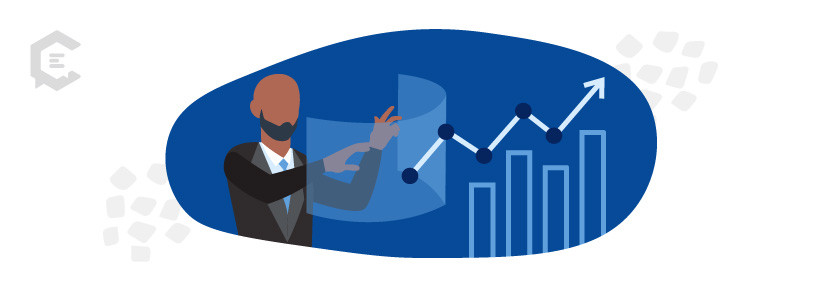Remember what the business world was like in the before times? Back then, predicting the future of your business wasn’t effortless, but it was a lot easier.
In fact, by crunching numbers or doing deep analysis on past successful campaigns versus the ones that never took off, you could often set up a roadmap for future success by learning to think like a futurist. Well, things aren’t quite that simple anymore.
Planning for the Future is Sometimes Complicated
By now, most of us realize that we’re now living in the new normal. And if we collectively share one takeaway from 2020 that we can continue to use in the decades to come, it’s that we probably can’t perfectly predict the way business might go in the future.
Besides, all the analytic data tools and sophisticated algorithms in the world might have been stumped by the after-effects of 2020. So what does that mean for the long-term viability of your own business?
Many business contracts and insurance policies build in for something called “Acts of God,” referring to things like tornadoes or earthquakes. But a global pandemic isn’t something most of us anticipated, so that means most of us have to start from scratch in trying to anticipate what’s next for our businesses.
Futurists Predict the Best Course for Their Businesses
As sci-fi intensive as the title sounds, a futurist is simply someone who studies a particular niche and then uses this knowledge to break down potential opportunities in the future.
And like artists, not all futurists follow a certain style. Some are social scientists, while others are former chief marketing officers who shifted careers. On some level, venture capitalists could be considered futurists as well.
They invest in fledgling companies they predict will succeed. If they’re right, their investments can pay off dramatically.
We all get thrown for a global loop with things like pandemics or market crashes. In thinking like a futurist, you can whittle down options and hopefully choose the best course for your business and future success.
3 Ways to Plan for the Future by Studying the Past
When trying to think like a futurist, it’s often a great idea to figure out what worked or failed in your professional past.
- What was your greatest professional success? Try to figure out if your moment of past glory can be successfully replicated. If not, how can you at least use the professional building blocks that brought you to that point?
- Which part of your great success was due to talent? A great team? Financial investment? Sheer luck? While you can’t replicate that last part, sometimes simply reminding yourself of the parts of a project that elevated it could help you figure out how to create an updated version of it.
- Are you aiming too high? By trying for business perfection, you could be leaving potentially valuable opportunities on the table. In analyzing your past successes, take a look at the smaller greatest moments as well and consider reviving or relaunching them.
2 Examples of Successful People Who Think Like Futurists
In case you’re worried that you can’t possibly think like a futurist, you might want to think again. In fact, on some level, you’re already doing just that.
1. An exec who combined Italy’s design aesthetic with his brand
Take the case of a wireless charging and telecommunications executive named Igor Spinella. He’s the CEO of Einova, a company specializing in wireless tech.
Spinella, who’s also a mechatronic engineer — a combination of robotics, electronics, computer, telecommunications, systems, control, and product engineering — combined the ancient luxury of his native Italy with modern wireless charging devices.
Spinella says that people don’t simply want great products; they also want the feel and look of luxury. Spinella is able to set its brand apart from its competitors because it isn’t just the components that are world-class — the actual products blend with home decor for seamless usage.
Spinella spent years studying the usage patterns, likes, and dislikes of those investing in charging devices to better understand future product trends. In one of his latest product launches, Charging Stones, the look of Italian marble plays heavily into the design.
More than that, products are designed with future-forward Qi-certified capabilities. And while these are relatively new to the market here in the U.S., Spinella is already concentrating on the next big thing in wireless tech.
Futurist-inspired takeaway: The technology, minimalist design, and marble used in the stones is heavily influenced by Italian design. But none of that would be appealing and relevant to wireless tech buyers if the products didn’t serve their immediate needs.
Spinella and his team realized several years ago that the future of tech beyond wireless would have to include timeless design as well. This forward-thinking approach went beyond creating something merely useful, with the understanding that, as we all use more devices, we’d want their accessories to enhance our homes as well.
2. A blockchain CEO committed to corporate social responsibility
Environmental, Social, and Corporate Governance (ESG) in investing is often fueled by a hope of investing in companies that support a more positive world outlook. This may include more energy-efficient companies, pay equity, or even more ethical boards. Many CEOs who have learned to think like futurists understand that companies that cut corners when it comes to employee safety or well-being may find themselves isolated and no longer desirable.
“To drive a more sustainable and responsible future, we need to understand that economic and social goals can be complementary instead of competitive, that profit should drive impact, and vice versa,” said Kim Raath, Ph.D., founder and CEO of Topl, an ESG technology company.
Raath worked in 18 developing countries to rebuild and strengthen communities by implementing innovative forms of technology. In that way, she came to understand that future innovation has to work for all, and not only the communities that are easier to reach. For a company, investing in communities or companies with a conscience brings with it a potentially great future payoff.
“Strong ESG or sustainability credentials foster brand recognition, trust, and customer loyalty,” Raath said. “Adopting these principles from the beginning gives a company a stronger and truer foundation. But to build such a social enterprise takes grit and resolve because even though ESG is a must-have today and is proving to be good business, you are a part of the force that is changing the way of business. And that takes some serious courage.”
Futurist-inspired takeaway: To best understand how to take care of future communities’ needs, you must compare many different communities and not only the one closest to you.
Futurists Connect with History and Community
Futurists understand that a great part of business success is connecting with people about things they love or enjoy.
- Is design part of your company’s overall ethos? Find ways to connect to past trends before setting your own.
- Is your company committed to giving back? Unless you support controversial causes, consider making your charitable donations visible, and share your predictions for future giving as well.
- Make your messaging easy to understand. Whether that involves humor or local heroes, it allows potential customers to connect with you informally before finding ways to support your brand and vision.
Developing a Futurist Mindset
For some business owners, thinking like a futurist allows them to be bolder with their future forecasts or expectations.
“I think like a futurist for my business in order to avoid getting into a fearful mindset,” said Lauren Petrullo, owner of digital marketing agency Mongoose Media. “There is so much fear and reaction happening with every new update and piece of news, so I work on staying in a futurist mindset to increase preparedness and forecast my business.”
Petrullo, the former innovation producer at The Walt Disney Company, does this by first staying up to date on the publicly traded software companies she uses and even by listening to their quarterly calls. Since she is also a co-owner of several additional businesses, Petrullo then reviews and analyzes scenarios as they affect her businesses in the future. So, for instance, she closely watches updates that potentially impact iOS devices since they ultimately affect her work in the digital advertising space.
2 Ways to Think Like a Futurist
In the investment world, a venture capitalist essentially frames their mindset on the return on investment possibilities of the future. Like a futurist, this means they gauge what worked then and then essentially bet on what might work in the future.
1. Be founder-focused
Big companies are often helmed by big personalities or those with groundbreaking or uniquely updated ideas.
“You can tell a lot about a company by who is working behind the scenes,” said Jeff Ransdell, managing director and founding partner of Fuel Venture Capital. “There are great companies with not-so-great founders. There are great founders with not-so-great companies. We do our due diligence, have an incredibly accomplished team of analysts, and structure and processes that we go through just to even start considering a company.”
Futurist-inspired takeaway: By understanding who runs the company, you have a better idea of how well the company will do in the future.
2. Be circumspect about what you share publicly
No matter how much time you spend analyzing statistics and making predictions, there are times you’ll be wrong. Sometimes it’s a blip. Sometimes it’s a great, big, humiliating error that people still quote years later. But even the most talented futurist isn’t a soothsayer or psychic. So learn to manage both your own expectations and that of your team and clients.
“We’re very careful about what we say,” Ransdell said in terms of predictions. “It’s important for marketers especially to take into account the unknown. What if the day before quarantine/lockdown we had made some bold prediction? Well, that would have been bad timing. You never know what’s going to happen tomorrow.”
That said, Ransdell added “you can’t take the easy way out. You’ve got to take chances. But you don’t have to guess. It’s important to have a good team around you giving solid advice.”
Futurist-inspired takeaway: Surround yourself with a great team, and then trust their collective advice.
3 Ways to Ignite Your Business:
- Don’t rush your product or idea to market. Spend enough time fine-tuning it to ensure your greatest possible success.
- Pay attention to global industry leaders. If they’re shying away from something, chances are it’s either overexposed or no longer relevant. Conversely, if everyone is working on a big idea, maybe it’s time to break out your own.
- Compare what they say to what they do. Along those lines, what’s the overall messaging like of your favorite company? Are they telling investors and consumers the same thing? If not, you don’t have to be a futurist to know there’s trouble brewing ahead for them. Avoid similar confusion in your own messaging whenever possible.’
Think like a futurist with content that solves customer problems and anticipates their questions. Talk to a content specialist at ClearVoice today to get started.






